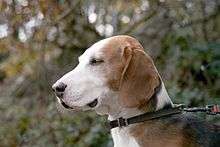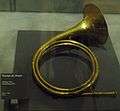German Hound
 Deutsche Bracke | |||||||||||
| Other names | Deutsche Bracke, German Bracke, Olper Bracke, Westphalian Bracke | ||||||||||
|---|---|---|---|---|---|---|---|---|---|---|---|
| Origin | Germany | ||||||||||
| |||||||||||
| Domestic dog (Canis lupus familiaris) | |||||||||||
The German Hound (Deutsche Bracke) (FCI No. 299) is a breed of dog originating in Westphalia, a region of Germany. The German Hound is of the scenthound type, used for hunting both large and small game. The breed is normally referred to as the Deutsche Bracke in English, rather than by the translation of the name, German Hound.
Appearance
The German Hound is a small hound, 40 – 53 cm (16 - 21 ins) at the withers, with long drop ears and a long narrow tail. It is distinguished by a long, somewhat narrow head, and a rectangular body, described as "elegant".[1]
The coat has hard, almost bristly, short fur, usually tricolor (red to yellow with a black mantle), with white markings called Bracken marks - a white muzzle, chest, legs, collar, and tip of the tail, and a blaze on the head.[2]
History
The Bracke are an ancient type of hound. Their distinctive narrow heads and long ears set them apart from other types of hounds, and may show influence of the Greyhound or the ancient Celtic hounds. The St. Hubert's Hound (Bloodhound) may have contributed to the Bracke's voice, the distinctive call made by the dogs while chasing game. Over a very long period of time Bracke developed into a variety of regional forms.[3]
In 1896 the Deutschen Bracken Club, encompassing all of the local types of Bracke in northwest Germany, was formed in Olpe. The breeds were merged in 1900 as one breed and were officially designated Deutsche Bracke.[2] This breed was formerly called by a variety of old regional names such as "Olpe Bracke", "Sauerländer Bracke" and "Westphalian Bracke", and other local types now blended into one breed. The only breeds of Bracke in the area today are the German Hound and the Westphalian Dachsbracke.[1] The Westphalian Dachsbracke is a short legged dog, possibly a cross of a Bracke with the Dachshund, the Westphalian Dachsbracke.[3]
Hunting with the Bracke in early times was done in mounted hunts, with hunters on horses following the hounds, as done by the ancient Celts chasing deer, and modern day fox hunters after fox. Another sport was developed in the 16th century, that did not require the expense of horses and big kennels, and made use of firearms, called Brackade. Hounds hunting this way tenaciously follow the game while voicing cries that communicate to the hunter as to where the dog is and what type of game the dog is following. Today, the Deutsche Bracke is usually used to hunt deer, but also rabbits and fox. Often it is hunted singly as a leash hound, in order to hunt on smaller areas.[4] The space needed to hunt a pack of hounds is described by the breed club as a minimum area of 1,000 ha (2471 acres).[5] Related to the hunting with Bracke is the use of horns to communicate with the dogs, a custom that is continued today.

The German Hound was recognized by the Verband für das Deutsche Hundewesen (German Kennel Club) through the Deutschen Bracken Club was formed in 1886 and continues today, and oversees breeding and hunt testing, as well as preserving traditions of Bracke hunting.[6] The German Hound was the first Bracke to be registered as a distinct breed, in 1900. and by the Fédération Cynologique Internationale as breed number 299 in Group 6 (Scenthounds), Section 1.3 (Small hounds).[7] Of the major kennel clubs in the English-speaking world, only the United Kennel Club in the US recognises the German Hound, in its Scenthound Group. The German Hound also may be recognised by any of the many minor registries, rare breed groups, hunting clubs, and internet registry businesses under its original name, discarded antique names, translations of the name, or variations on the name. The German Hound is strictly a hunting dog, and seldom seen outside its native country.[1] Outside the home country, purchasers of dogs represented as German Hound should research the dog's background, especially if it is registered with one of the minor clubs that require little to no documentation before accepting a dog or litter for registration.
Names
Historically, the term Bracke was used in German to mean the scenthounds. Brack is an old Low German word for a coastal marsh periodically inundated by storm surges with salt water-the English word brackish.[8] In Europe, scenthounds are usually separated into running hounds (free running packs, which either drive the game back to the hunter, or the hunter follows as they run, or the hunter waits until the dogs' cries communicate that game has been found and held, and then goes to that spot) or leash hounds (which follow the game or track wounded or dead game while being held on a leash by the hunter.) The Bracke are usually used as running hounds, in packs, to hunt rabbits or foxes in a type of hunt called Brackade.
Health and character
No specific diseases or claims of extraordinary health have been documented for this breed. According to the original German breed club, although it is a hunting dog it is affectionate and benefits from living with the family rather than in a kennel. It is a very persistent tracking dog with a good sense of direction.[5]
Related breeds
The German Hound is related to the Westfälische Dachsbracke (Westphalian Dachsbracke, FCI No. 254) and the Drever, also called the Swedish Dachsbracke. The Finnenbracke (No. 51) is from Finland. The Alpenländische Dachsbracke (Alpine Dachsbracke, FCI No. 254) is from Tyrol, in Austria, as is the Tiroler Bracke or Tyrol Hound (FCI No. 68).
See also
References
- 1 2 3 Clark, Anne Rogers; Andrew H. Brace (1995). The International Encyclopedia of Dogs. Howell Book House. p. 202. ISBN 0-87605-624-9.
- 1 2 Breed Standard
- 1 2 History, Deutscher Bracken Club (in German)
- ↑ Hunting with Bracke (in German)
- 1 2 The Deutsche Bracke
- ↑ Verband für das Deutsche Hundewesen (in German)
- ↑ Fédération Cynologique Internationale Group 6 Archived December 26, 2008, at the Wayback Machine.
- ↑ "Scharze Brack und der Deichbau".